Santa Maria | |
|---|---|
| Municipality of Santa Maria | |
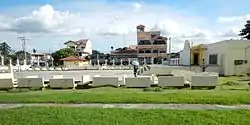 Municipal plaza | |
 Seal | |
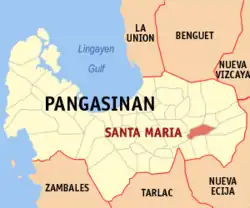 Map of Pangasinan with Santa Maria highlighted | |
OpenStreetMap | |
.svg.png.webp) Santa Maria Location within the Philippines | |
| Coordinates: 15°58′51″N 120°42′01″E / 15.98083°N 120.70028°E | |
| Country | Philippines |
| Region | Ilocos Region |
| Province | Pangasinan |
| District | 6th district |
| Barangays | 23 (see Barangays) |
| Government | |
| • Type | Sangguniang Bayan |
| • Mayor | Julius C. Ramos |
| • Vice Mayor | Teodoro A. Ramos |
| • Representative | Tyrone D. Agabas |
| • Municipal Council | Members |
| • Electorate | 22,765 voters (2022) |
| Area | |
| • Total | 69.50 km2 (26.83 sq mi) |
| Elevation | 45 m (148 ft) |
| Highest elevation | 68 m (223 ft) |
| Lowest elevation | 32 m (105 ft) |
| Population (2020 census)[3] | |
| • Total | 34,220 |
| • Density | 490/km2 (1,300/sq mi) |
| • Households | 8,249 |
| Economy | |
| • Income class | 4th municipal income class |
| • Poverty incidence | 11.08 |
| • Revenue | ₱ 134.3 million (2020) |
| • Assets | ₱ 356.5 million (2020) |
| • Expenditure | ₱ 122.5 million (2020) |
| • Liabilities | ₱ 25.27 million (2020) |
| Service provider | |
| • Electricity | Dagupan Electric Corporation (DECORP) |
| Time zone | UTC+8 (PST) |
| ZIP code | 2440 |
| PSGC | |
| IDD : area code | +63 (0)75 |
| Native languages | Pangasinan Ilocano Tagalog |
| Website | www |
Santa Maria, officially the Municipality of Santa Maria (Pangasinan: Baley na Santa Maria; Ilocano: Ili ti Santa Maria; Tagalog: Bayan ng Santa Maria), is a 4th class municipality in the province of Pangasinan, Philippines. According to the 2020 census, it has a population of 34,220 people.[3]
Santa Maria is 72 kilometres (45 mi) from Lingayen and 188 kilometres (117 mi) from Manila.
History
Spanish colonial era
Santa Maria was formerly a barrio of the Municipality of Tayug. It was founded on January 10, 1855 as a separate town and was governed by a captain until 1863. In 1864, the town was incorporated into the municipality of Tayug due to its inability to maintain its financial stability.
In 1877 the inhabitants of Santa Maria applied for separation, as a distinct municipality, from the municipality of Tayug. The application was granted and Santa Maria, again became a town under the governance of Captain Eugenio Vinluan.
For many years, during the Spanish Regime, religion was the basis of educating the masses. From time to time missionaries of different orders were sent out to Santa Maria to carry out religious services as required of them. It was during the routine visit of a certain priest from the town of Asingan, which was then the most eastern town of the province of Pangasinan, who had extended his mission farther into the east and came to a village. The village was located on a plain in which the Agno River ran and which with a little effort could be irrigated. The missionary believed that the village could be developed into a prosperous community. Finding the residents to be hospitable, he chatted with them and, in the course of conversation, he thought of giving the place a name. Since it was the Virgin Mary's Day, he called the people of the village to him and with a simple but impressive solemnity proclaimed this place as Santa Maria on this, the Virgin Mary's day.
American invasion era
In 1903, the Americans arrived in Santa Maria and their rule began. In 1901 there was an election for the president of Santa Maria. This was during the United States military government of the islands. The President was given a two years term, due to his good administration.
In 1903, Santa Maria was incorporated again into the town of Tayug for financial reasons, as before, but in 1907 a special election was held for the purpose of returning all small municipalities that had incorporated with bigger towns. Don Alejandro Gonzales was then elected president and served until 1910 when he was succeeded by Don Mariano de Guzman who served to 1912. From this date to the present, the different successions of presidents, alcaldes and mayors had occurred all over the islands.
Contemporary
In the course of time prominent people improved the locality and transferred the town site from Namagbagan, which is now a barrio of the municipality, to its present site near a clay promontory where it formed an impregnable defense against the yearly erosion of the Agno, thus annexing "De Pila" to the original name and making Santa Maria de Pila its final name, a name which is known beyond the confines of the province of Pangasinan.
The town's much progressive due to close proximity to neighboring towns of Rosales and Tayug.
Geography
Barangays
Santa Maria is politically subdivided into 23 barangays. Each barangay consists of puroks and some have sitios.
- Bal-loy
- Bantog
- Caboluan
- Cal-litang
- Capandanan
- Cauplasan
- Dalayap
- Libsong
- Namagbagan
- Paitan
- Pataquid
- Pilar
- Poblacion East
- Poblacion West
- Pugot
- Samon
- San Alejandro
- San Mariano
- San Pablo
- San Patricio
- San Vicente
- Santa Cruz
- Sta. Rosa
Climate
| Climate data for Santa Maria, Pangasinan | |||||||||||||
|---|---|---|---|---|---|---|---|---|---|---|---|---|---|
| Month | Jan | Feb | Mar | Apr | May | Jun | Jul | Aug | Sep | Oct | Nov | Dec | Year |
| Mean daily maximum °C (°F) | 29 (84) |
29 (84) |
30 (86) |
32 (90) |
33 (91) |
33 (91) |
33 (91) |
33 (91) |
33 (91) |
32 (90) |
31 (88) |
29 (84) |
31 (88) |
| Mean daily minimum °C (°F) | 21 (70) |
21 (70) |
22 (72) |
23 (73) |
24 (75) |
24 (75) |
24 (75) |
24 (75) |
23 (73) |
23 (73) |
22 (72) |
21 (70) |
23 (73) |
| Average precipitation mm (inches) | 127.5 (5.02) |
115.8 (4.56) |
129.7 (5.11) |
141.1 (5.56) |
248.2 (9.77) |
165 (6.5) |
185.3 (7.30) |
161.9 (6.37) |
221.4 (8.72) |
299.5 (11.79) |
199 (7.8) |
188.7 (7.43) |
2,183.1 (85.93) |
| Average rainy days | 17 | 17 | 17 | 15 | 20 | 19 | 19 | 20 | 21 | 20 | 17 | 19 | 221 |
| Source: World Weather Online[5] | |||||||||||||
Demographics
| Year | Pop. | ±% p.a. |
|---|---|---|
| 1903 | 7,628 | — |
| 1918 | 7,362 | −0.24% |
| 1939 | 10,295 | +1.61% |
| 1948 | 12,802 | +2.45% |
| 1960 | 14,230 | +0.89% |
| 1970 | 16,296 | +1.36% |
| 1975 | 18,766 | +2.87% |
| 1980 | 19,018 | +0.27% |
| 1990 | 23,793 | +2.27% |
| 1995 | 25,278 | +1.14% |
| 2000 | 27,860 | +2.11% |
| 2007 | 30,721 | +1.36% |
| 2010 | 31,091 | +0.44% |
| 2015 | 33,038 | +1.16% |
| 2020 | 34,220 | +0.69% |
| Source: Philippine Statistics Authority[6][7][8][9] | ||
Economy
Geography
Local government
Santa Maria, belonging to the sixth congressional district of the province of Pangasinan, is governed by a mayor designated as its local chief executive and by a municipal council as its legislative body in accordance with the Local Government Code. The mayor, vice mayor, and the councilors are elected directly by the people through an election which is being held every three years.
Elected officials
| Position | Name |
|---|---|
| Congressman | Tyrone D. Agabas |
| Mayor | Julius C. Ramos |
| Vice-Mayor | Teodoro A. Ramos |
| Councilors | Rex R. Navarrete |
| Noela L. Agpawa | |
| Arnel B. Ginez | |
| Felicisima D. Agpawa | |
| Reynaldo D. Segui Jr. | |
| Pedro A. Tugade Jr. | |
| Justino Dominador C. Rodriguez Jr. | |
| Rolando R. dela Peña | |
Gallery
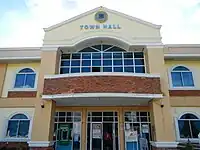 Santa Maria Town Hall
Santa Maria Town Hall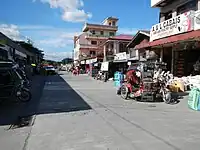 Public Market road to municipal hall and public park
Public Market road to municipal hall and public park Public market
Public market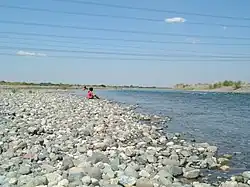 Part of Agno River flowing near Barangay San Vicente, Santa Maria Pangasinan. A faint image of Narciso Ramos Bridge can be seen at a distance.
Part of Agno River flowing near Barangay San Vicente, Santa Maria Pangasinan. A faint image of Narciso Ramos Bridge can be seen at a distance.
References
- ↑ Municipality of Santa Maria | (DILG)
- ↑ "2015 Census of Population, Report No. 3 – Population, Land Area, and Population Density" (PDF). Philippine Statistics Authority. Quezon City, Philippines. August 2016. ISSN 0117-1453. Archived (PDF) from the original on May 25, 2021. Retrieved July 16, 2021.
- 1 2 Census of Population (2020). "Region I (Ilocos Region)". Total Population by Province, City, Municipality and Barangay. Philippine Statistics Authority. Retrieved July 8, 2021.
- ↑ "PSA Releases the 2018 Municipal and City Level Poverty Estimates". Philippine Statistics Authority. December 15, 2021. Retrieved January 22, 2022.
- ↑ "Santa Maria, Pangasinan: Average Temperatures and Rainfall". World Weather Online. Retrieved October 31, 2015.
- ↑ Census of Population (2015). "Region I (Ilocos Region)". Total Population by Province, City, Municipality and Barangay. Philippine Statistics Authority. Retrieved June 20, 2016.
- ↑ Census of Population and Housing (2010). "Region I (Ilocos Region)" (PDF). Total Population by Province, City, Municipality and Barangay. National Statistics Office. Retrieved June 29, 2016.
- ↑ Censuses of Population (1903–2007). "Region I (Ilocos Region)". Table 1. Population Enumerated in Various Censuses by Province/Highly Urbanized City: 1903 to 2007. National Statistics Office.
{{cite encyclopedia}}: CS1 maint: numeric names: authors list (link) - ↑ "Province of Pangasinan". Municipality Population Data. Local Water Utilities Administration Research Division. Retrieved December 17, 2016.
- ↑ "Poverty incidence (PI):". Philippine Statistics Authority. Retrieved December 28, 2020.
- ↑ "Estimation of Local Poverty in the Philippines" (PDF). Philippine Statistics Authority. November 29, 2005.
- ↑ "2003 City and Municipal Level Poverty Estimates" (PDF). Philippine Statistics Authority. March 23, 2009.
- ↑ "City and Municipal Level Poverty Estimates; 2006 and 2009" (PDF). Philippine Statistics Authority. August 3, 2012.
- ↑ "2012 Municipal and City Level Poverty Estimates" (PDF). Philippine Statistics Authority. May 31, 2016.
- ↑ "Municipal and City Level Small Area Poverty Estimates; 2009, 2012 and 2015". Philippine Statistics Authority. July 10, 2019.
- ↑ "PSA Releases the 2018 Municipal and City Level Poverty Estimates". Philippine Statistics Authority. December 15, 2021. Retrieved January 22, 2022.
- ↑ "2019 National and Local Elections" (PDF). Commission on Elections. Retrieved March 7, 2022.
External links
- Santa Maria Profile at PhilAtlas.com
- Municipal Profile at the National Competitiveness Council of the Philippines Archived October 26, 2017, at the Wayback Machine
- Santa Maria at the Pangasinan Government Website Archived November 19, 2018, at the Wayback Machine
- Local Governance Performance Management System Archived October 10, 2016, at the Wayback Machine
- Philippine Standard Geographic Code
- Philippine Census Information
- Official Website of Santa Maria Pangasinan